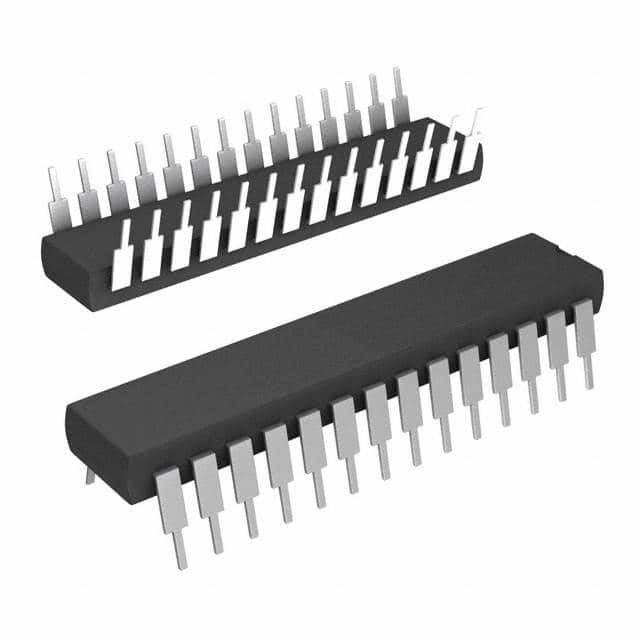TLC5940NT
Product Overview
- Category: Integrated Circuit
- Use: LED Driver
- Characteristics:
- High grayscale PWM control
- 16-channel constant current sink driver
- Daisy-chainable for multiple devices
- Wide operating voltage range
- Thermal shutdown protection
- Package: DIP-28, SOP-28
- Essence: The TLC5940NT is a versatile LED driver IC that provides high-quality grayscale PWM control for driving LEDs in various applications.
- Packaging/Quantity: Available in tubes or reels, with 25 pieces per tube/reel.
Specifications
- Operating Voltage Range: 3V to 5.5V
- Output Current: Up to 120 mA per channel
- Gray Scale Control: 4096 steps (12-bit)
- Data Transfer Interface: Serial data input and output
- Operating Temperature Range: -40°C to +85°C
Pin Configuration
The TLC5940NT has a total of 28 pins, which are assigned as follows:
- VCC
- GND
- BLANK
- XLAT
- SCLK
- SIN
- SOUT
- XERR
- GSCLK
- OUT0
- OUT1
- OUT2
- OUT3
- OUT4
- OUT5
- OUT6
- OUT7
- OUT8
- OUT9
- OUT10
- OUT11
- OUT12
- OUT13
- OUT14
- OUT15
- IREF
- VPRG
- VPROG
Functional Features
- High Grayscale PWM Control: The TLC5940NT supports 12-bit grayscale control, allowing for smooth and precise brightness adjustment of connected LEDs.
- Multiple Channel Output: With 16 channel outputs, the TLC5940NT can drive a wide range of LEDs individually or in groups.
- Daisy-Chaining Capability: Multiple TLC5940NT devices can be daisy-chained together to expand the number of controllable LED channels.
- Thermal Shutdown Protection: The IC includes built-in thermal shutdown protection to prevent damage due to excessive heat.
Advantages and Disadvantages
Advantages: - Precise grayscale control for smooth LED dimming - High output current capability - Daisy-chainable for scalability - Wide operating voltage range allows compatibility with various power sources
Disadvantages: - Requires external resistors for current setting - Limited number of output channels compared to some other LED driver ICs
Working Principles
The TLC5940NT is designed to provide accurate and efficient LED driving capabilities. It utilizes pulse-width modulation (PWM) to control the brightness of individual LEDs. The IC receives serial data input, which contains grayscale information for each LED channel. It then converts this data into PWM signals, adjusting the duty cycle to achieve the desired brightness level. The TLC5940NT also incorporates a constant current sink driver, ensuring consistent LED performance.
Application Field Plans
The TLC5940NT finds applications in various fields, including:
- LED Lighting: Suitable for controlling LED strips, panels, and bulbs in residential, commercial, and industrial lighting systems.
- Display Systems: Used in LED matrix displays, scoreboards, signage, and large-scale video walls.
- Automotive Lighting: Enables precise control of LED headlights, taillights, and interior lighting in vehicles.
- Gaming and Entertainment: Provides dynamic lighting effects in gaming peripherals, stage lighting, and entertainment venues.
- Art Installations: Ideal for creating interactive LED art installations and sculptures.
Alternative Models
- TLC5941NT: Similar to TLC5940NT, but with 24 channel outputs instead of 16.
- IS31FL3733: LED driver IC with 12-bit grayscale control and 16 channel outputs.
- MAX7219: LED display driver IC with serial interface and support for up to 64 individual LEDs.
Note: The above alternative models are just a few examples; there are several other LED driver ICs available in the market.
This entry provides an overview of the TLC5940NT LED driver IC, including its basic information, specifications, pin configuration, functional features, advantages and disadvantages, working principles, application field plans, and alternative models.
Senaraikan 10 soalan dan jawapan biasa yang berkaitan dengan aplikasi TLC5940NT dalam penyelesaian teknikal
Sure! Here are 10 common questions and answers related to the application of TLC5940NT in technical solutions:
Q: What is TLC5940NT? A: TLC5940NT is a popular LED driver IC (integrated circuit) that can control multiple LEDs with individual brightness levels.
Q: How many LEDs can be controlled using TLC5940NT? A: TLC5940NT can control up to 16 channels, which means it can drive up to 16 LEDs independently.
Q: Can TLC5940NT control RGB LEDs? A: Yes, TLC5940NT can control RGB LEDs by using three channels for each color component (red, green, and blue).
Q: What is the maximum current that TLC5940NT can handle? A: TLC5940NT can handle a maximum current of 120 mA per channel, and a total current of 720 mA across all channels.
Q: How does TLC5940NT communicate with a microcontroller? A: TLC5940NT uses a serial interface (SPI) to communicate with a microcontroller, allowing for easy integration into various systems.
Q: Can TLC5940NT be daisy-chained to control more than 16 LEDs? A: Yes, multiple TLC5940NT ICs can be daisy-chained together to control a larger number of LEDs, as long as the current limits are respected.
Q: Does TLC5940NT support dimming and fading effects? A: Yes, TLC5940NT supports smooth dimming and fading effects by adjusting the brightness levels of individual LEDs over time.
Q: Can TLC5940NT be used in automotive applications? A: Yes, TLC5940NT is suitable for automotive applications as it can handle a wide operating voltage range and is resistant to temperature variations.
Q: Are there any limitations to using TLC5940NT? A: One limitation is that TLC5940NT requires external resistors for current limiting, which adds complexity to the circuit design.
Q: Where can I find example code and application notes for TLC5940NT? A: You can find example code and application notes for TLC5940NT on the manufacturer's website or online forums dedicated to electronics and microcontrollers.
Please note that these answers are general and may vary depending on specific implementation details and requirements.


